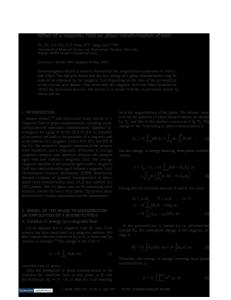Effect of alumina-doping on grain boundary segregation-induced phase transformation in yttria-stabilized tetragonal zirc
- PDF / 755,239 Bytes
- 12 Pages / 585 x 783 pts Page_size
- 22 Downloads / 309 Views
Hidehiro Yoshida National Institute for Materials Science, Tsukuba, Ibaraki 305-0047 Japan
Yuichi Ikuhara Institute of Engineering Innovation, School of Engineering, The University of Tokyo, Bunkyo-ku, Tokyo 113-8656, Japan (Received 14 March 2006; accepted 3 May 2006)
The microstructure in a small amount of Al2O3-doped Y2O3-stabilized tetragonal zirconia polycrystal (Y-TZP) sintered at 1100–1650 °C was examined to clarify the effect of Al3+ ions segregated at grain boundaries on cubic-formation and grain-growth processes. The sintering rate in Y-TZP was remarkably enhanced by Al2O3-doping. In addition, at temperatures >1500 °C, grain growth remarkably proceeded, and the fraction of the cubic phase increased in comparison with that of undoped Y-TZP. High-resolution electron microscopy and nanoprobe x-ray energy dispersive spectroscopy measurements revealed that no amorphous layer existed along the grain-boundary faces in Al2O3-doped Y-TZP and that Y3+ and Al3+ ions segregated at grain boundaries over widths of ∼10 and ∼6 nm, respectively. At 1100 °C, Al3+ ions started to segregate at grain boundaries, and the segregation peak of Al3+ ions increased as the sintering temperature increased. Cubic-formation and grain-growth behaviors in Al2O3-doped Y-TZP were reasonably interpreted by taking into account the effect of Al3+ ions segregating along grain boundaries.
I. INTRODUCTION
Yttria-stabilized tetragonal zirconia polycrystal (YTZP) is an important structural ceramic with excellent mechanical properties, such as high fracture toughness, strength, and hardness, and is used for products such as optical fiber connectors, grinding media, and precision mechanical parts. The hydrolysis process is the best industrial manufacture method for producing Y-TZP powder. To develop new Y-TZP powder with forming and sintering characteristics by the hydrolysis process, it is particularly important to clarify the sintering mechanism in Y-TZP. So far, two models based on the solute-drag effect and Zener’s pinning effect have been proposed to understand the grain-growth behavior in Y-TZP. The model of the solute-drag effect in Y-TZP was first proposed by Lee and Chen1 to explain the slow grain-growth behavior
a)
Address all correspondence to this author. e-mail: [email protected] DOI: 10.1557/JMR.2006.0274 2278
J. Mater. Res., Vol. 21, No. 9, Sep 2006
found in Y-TZP in comparison to that in Y2O3-stabilized cubic zirconia. The model of the Zener’s pinning effect was firstly proposed by Lange.2 Subsequently, Sakuma and Yoshizawa3,4 quantitatively analyzed the graingrowth process using a rate equation based on Zener’s pinning model to interpret the grain growth of dual-phase ZrO2 generated after the equilibrium partitioning. Grainboundary characterization is a key to reveal the graingrowth mechanism. The grain-boundary structure in YTZP was intensively investigated by high-resolution electron microscopy (HREM), and it had been concluded that an amorphous phase existed in grain boundaries.5–10 However, Ikuhara et al.11 first repor
Data Loading...











